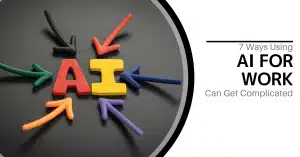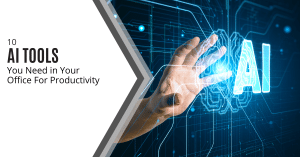Discover the potential pitfalls of AI in the workplace. This comprehensive guide explores 7 ways using AI for work can get complicated, including job displacement, ethical concerns, and data security. While AI offers numerous benefits, it also introduces a range of complications that businesses must address to ensure successful implementation and avoid potential pitfalls. This article explores seven critical ways using AI for work can get complicated, providing insights and strategies to navigate these challenges effectively.
Table of Contents:
Introduction: The Double-Edged Sword of AI in the Workplace
Job Displacement and the Evolving Skill Landscape
Ethical and Privacy Concerns: Navigating the Moral Minefield
Dependence and System Failures: The Risk of Over-Reliance
Data Privacy and Security Breaches: Protecting Sensitive Information
Algorithmic Discrimination: Ensuring Fairness in AI Decisions
Incorrect Information: The Pitfalls of AI-Generated Content
Loss of Creativity: The Impact on Human Innovation
Chart: Complications of AI in the Workplace
Table: Balancing AI Benefits and Complications
Conclusion: Navigating the AI Landscape with Caution and Foresight
FAQ: Frequently Asked Questions
Introduction: The Double-Edged Sword of AI in the Workplace
AI’s potential to revolutionize work is undeniable. From automating mundane tasks to providing data-driven insights, AI is reshaping industries across the board. Yet, the path to AI adoption is fraught with complexities. Organizations must be aware of these challenges to fully leverage AI’s capabilities while mitigating risks. Understanding these complications is crucial for fostering a harmonious coexistence between humans and machines in the workplace. This article delves into the specific areas where AI can introduce complexities, offering a comprehensive guide for businesses seeking to harness AI’s power responsibly.
Job Displacement and the Evolving Skill Landscape
One of the most significant concerns surrounding AI in the workplace is its potential to displace human workers. As AI-powered automation becomes more sophisticated, many routine and repetitive tasks traditionally performed by humans are now being handled by machines. This shift can lead to job losses, particularly in sectors such as manufacturing, data entry, and customer service.
The Rise of Automation
Automation, driven by AI, is reshaping the job market. Tasks that were once labor-intensive can now be completed faster and more efficiently by AI systems. This trend raises questions about the future of work and the role of human employees in an increasingly automated environment.
The Widening Skill Gap
While AI may eliminate some jobs, it also creates new opportunities. However, these new roles often require advanced technical skills, leading to a widening skill gap. Many workers lack the necessary training to transition into these AI-related positions, potentially exacerbating unemployment and inequality.
Strategies for Mitigation
To address the challenges of job displacement and skill gaps, organizations must invest in proactive strategies:
- Upskilling and Reskilling Programs: Companies should provide employees with training opportunities to acquire new skills relevant to the AI-driven workplace.
- Focus on Human-AI Collaboration: Emphasize the importance of humans and AI working together, leveraging the strengths of both.
- Invest in Education: Support educational initiatives that prepare the workforce for the future of work.
Ethical and Privacy Concerns: Navigating the Moral Minefield
AI systems are trained on vast amounts of data, and if this data reflects existing biases, the AI can perpetuate and even amplify these biases. This can lead to unfair or discriminatory outcomes in various workplace processes, such as hiring, promotions, and performance evaluations.
Algorithmic Bias
Algorithmic bias occurs when AI systems make decisions based on biased data, resulting in discriminatory outcomes. This can have significant legal and ethical implications for organizations.
Data Privacy
AI systems often require access to sensitive employee data, raising concerns about privacy and data security. Organizations must ensure that they comply with data protection regulations and implement robust security measures to safeguard employee information.
Transparency and Accountability
It is essential to understand how AI systems make decisions. Transparency and accountability are crucial for building trust and ensuring that AI is used ethically in the workplace.
Strategies for Mitigation
To address ethical and privacy concerns, organizations should:
- Implement Explainable AI (XAI): Use AI systems that provide clear explanations of their decision-making processes.
- Conduct Bias Audits: Regularly audit AI systems to identify and mitigate biases.
- Establish Data Governance Policies: Implement clear policies for data collection, storage, and usage.
Dependence and System Failures: The Risk of Over-Reliance
Over-reliance on AI without a thorough understanding of its limitations can lead to critical system errors, inaccurate predictions, and unexpected malfunctions. While AI can handle many tasks efficiently, it may struggle with nuanced contexts or unexpected situations.
The Black Box Problem
Many AI systems operate as “black boxes,” making it difficult to understand how they arrive at their conclusions. This lack of transparency can lead to a blind trust in AI, even when it produces incorrect or unreliable results.
Brittle Decision-Making
AI systems can be brittle, meaning they perform well under normal conditions but fail when faced with unexpected or unusual situations. This can be particularly problematic in high-stakes environments where errors can have significant consequences.
Strategies for Mitigation
To mitigate the risks of dependence and system failures, organizations should:
- Implement Continuous Monitoring: Regularly monitor AI systems to detect and address errors or malfunctions.
- Conduct Robust Testing: Thoroughly test AI systems under various conditions to identify potential weaknesses.
- Maintain Human Oversight: Ensure that humans remain in the loop to provide oversight and intervene when necessary.
Data Privacy and Security Breaches: Protecting Sensitive Information
The increasing presence of AI in workplaces multiplies the risks to data privacy and security. AI-powered workplace tools can create new weak points in data protection systems, making it challenging to protect sensitive information.
Vulnerabilities in AI Systems
AI systems can be vulnerable to cyberattacks, potentially exposing sensitive data to unauthorized access. Organizations must implement robust security measures to protect their AI systems from threats.
Insider Threats
AI systems can also be vulnerable to insider threats, where employees with malicious intent exploit their access to steal or misuse data. Organizations must implement strict access controls and monitoring systems to prevent insider threats.
Strategies for Mitigation
To address data privacy and security breaches, organizations should:
- Implement Robust Security Measures: Use firewalls, intrusion detection systems, and other security tools to protect AI systems from cyberattacks.
- Conduct Regular Security Audits: Regularly audit AI systems to identify and address vulnerabilities.
- Implement Strict Access Controls: Limit access to sensitive data and AI systems to authorized personnel only.
Algorithmic Discrimination: Ensuring Fairness in AI Decisions
Companies can face legal issues when AI exhibits bias in decisions related to hiring, promotion, or firing. This can occur when AI systems learn from historically biased data or develop unexpected discriminatory patterns.
Bias in Hiring
AI systems used for recruitment can perpetuate biases if they are trained on data that reflects existing inequalities. This can lead to discriminatory hiring practices and limit opportunities for underrepresented groups.
Bias in Promotions
AI systems used for performance evaluations and promotions can also exhibit bias, potentially disadvantaging certain employees. This can undermine morale and create a toxic work environment.
Strategies for Mitigation
To ensure fairness in AI decisions, organizations should:
- Use Diverse Training Data: Train AI systems on diverse and representative datasets to minimize bias.
- Conduct Regular Bias Audits: Regularly audit AI systems to identify and mitigate biases.
- Establish Clear Guidelines: Implement clear guidelines for the use of AI in hiring, promotions, and other workplace decisions.
Incorrect Information: The Pitfalls of AI-Generated Content
AI can sometimes provide wrong information by mixing up facts or using outdated data, which can cause significant problems. Additionally, AI can generate nonsensical outputs or create odd images, wasting time and causing confusion.
Hallucinations in AI Models
AI models, especially large language models, can sometimes generate incorrect or nonsensical information, a phenomenon known as “hallucinations.” This can be problematic when AI is used for critical decision-making or content creation.
Outdated Information
AI systems rely on data to make decisions, and if this data is outdated, the AI can produce inaccurate or irrelevant results. Organizations must ensure that their AI systems are trained on up-to-date and reliable data.
Strategies for Mitigation
To address the issue of incorrect information, organizations should:
- Implement Data Validation Processes: Regularly validate the data used to train and operate AI systems.
- Use Multiple Sources: Cross-reference information from multiple sources to ensure accuracy.
- Maintain Human Oversight: Ensure that humans review and verify AI-generated content before it is used.
Loss of Creativity: The Impact on Human Innovation
The use of AI in creative fields carries the risk of reduced creativity. Over-reliance on AI-generated content may diminish the time spent on creative thinking.
Dependence on AI Tools
AI-powered tools can automate many aspects of the creative process, potentially reducing the need for human input. This can lead to a dependence on AI and a decline in original thinking.
Homogenization of Content
AI systems can generate content that is similar to existing material, leading to a homogenization of creative output. This can stifle innovation and limit the diversity of ideas.
Strategies for Mitigation
To preserve creativity in the age of AI, organizations should:
- Encourage Experimentation: Encourage employees to experiment with AI tools while also fostering independent thinking.
- Promote Collaboration: Encourage collaboration between humans and AI, leveraging the strengths of both.
- Value Originality: Recognize and reward original thinking and creativity.
Chart: Complications of AI in the Workplace
| Complication | Description | Mitigation Strategies |
|---|---|---|
| Job Displacement | AI automation leads to job losses, particularly in routine tasks. | Upskilling and reskilling programs, focus on human-AI collaboration. |
| Ethical and Privacy Concerns | Biased AI decisions, data privacy violations, lack of transparency. | Explainable AI, bias audits, data governance policies. |
| System Failures | Over-reliance on AI leads to errors, malfunctions, and brittle decision-making. | Continuous monitoring, robust testing, human oversight. |
| Data Breaches | AI tools create vulnerabilities in data protection systems. | Robust security measures, regular security audits, strict access controls. |
| Algorithmic Discrimination | AI systems exhibit bias in hiring, promotions, and other decisions. | Diverse training data, regular bias audits, clear guidelines. |
| Incorrect Information | AI generates incorrect or outdated information. | Data validation processes, use multiple sources, human oversight. |
| Loss of Creativity | Over-reliance on AI diminishes human creativity and innovation. | Encourage experimentation, promote collaboration, value originality. |
Table: Balancing AI Benefits and Complications
| Benefit | Complication | Mitigation Strategy |
|---|---|---|
| Increased Efficiency | Job Displacement | Upskilling and reskilling programs. |
| Enhanced Productivity | Ethical and Privacy Concerns | Implement explainable AI and data governance policies. |
| Data-Driven Insights | System Failures | Continuous monitoring and human oversight. |
| Automation of Routine Tasks | Data Breaches | Robust security measures and regular audits. |
| Improved Decision-Making | Algorithmic Discrimination | Diverse training data and bias audits. |
| Innovation | Incorrect Information | Data validation processes and multiple sources. |
| Cost Reduction | Loss of Creativity | Encourage experimentation and value originality. |
Conclusion: Navigating the AI Landscape with Caution and Foresight
7 Ways Using AI for Work Can Get Complicated highlight the importance of a balanced and thoughtful approach to AI implementation. While AI offers immense potential, it also poses significant challenges that organizations must address proactively. By understanding these complications and implementing effective mitigation strategies, businesses can harness the power of AI while minimizing its risks. As AI continues to evolve, it is crucial to stay informed, adapt to changing circumstances, and prioritize ethical considerations to ensure a sustainable and equitable future of work. By navigating the AI landscape with caution and foresight, organizations can unlock the full potential of AI while safeguarding the interests of their employees and stakeholders.
FAQ: Frequently Asked Questions
Q: What are the main concerns regarding AI in the workplace?
A: The main concerns include job displacement, ethical and privacy issues, dependence on AI systems, data security breaches, algorithmic discrimination, incorrect information, and loss of creativity.
Q: How can companies address job displacement caused by AI?
A: Companies can invest in upskilling and reskilling programs to help employees transition to new roles that require different skills. They can also focus on human-AI collaboration, leveraging the strengths of both.
Q: What is algorithmic bias, and how can it be mitigated?
A: Algorithmic bias occurs when AI systems make decisions based on biased data, leading to discriminatory outcomes. It can be mitigated by using diverse training data, conducting regular bias audits, and establishing clear guidelines for AI usage.
Q: How can organizations protect sensitive data when using AI?
A: Organizations can implement robust security measures, conduct regular security audits, and enforce strict access controls to limit access to sensitive data and AI systems.
Q: What is Explainable AI (XAI), and why is it important?
A: Explainable AI (XAI) refers to AI systems that provide clear explanations of their decision-making processes. It is important because it promotes transparency, builds trust, and allows for human oversight.
Q: How can companies ensure that AI does not diminish creativity in the workplace?
A: Companies can encourage experimentation with AI tools while also fostering independent thinking, promoting collaboration between humans and AI, and valuing originality.
Q: What steps should companies take before implementing AI in their workplace?
A: Companies should assess their readiness for AI, identify specific goals and use cases, ensure data quality and security, and provide adequate training for employees. They should also consider the ethical implications and establish clear guidelines for AI usage.










